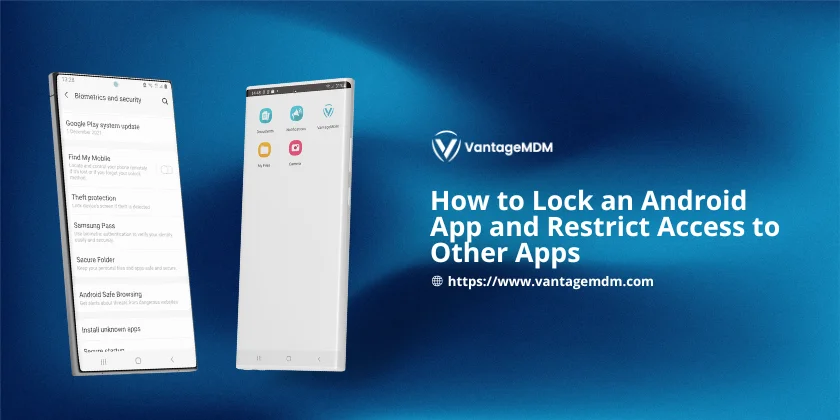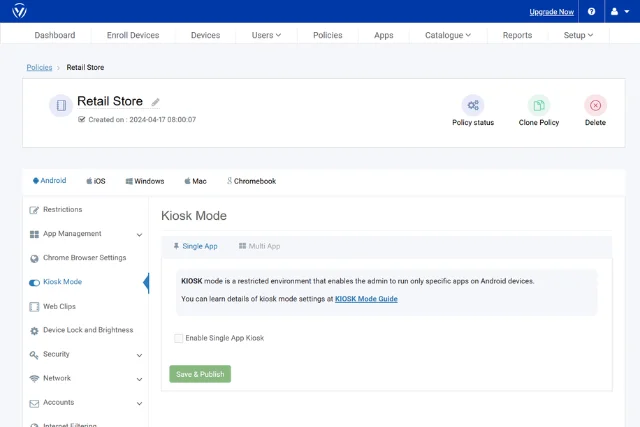How to Lock an Android App and Restrict Access to Other Apps

In an age where our smartphones hold everything from family photos to sensitive business data, controlling who can access your apps isn’t just a convenience—it’s a necessity. Whether you’re a parent trying to shield your child from social media distractions, a professional safeguarding confidential work apps, or a business owner managing a fleet of tablets for customer use, knowing how to lock an Android app—or even the entire device—is a skill worth mastering.
This guide isn’t just about technical steps. We’ll explore real-world scenarios, share practical tips, and even troubleshoot common pitfalls. By the end, you’ll know exactly how to balance security with usability, whether you’re protecting a single app or locking down a dozen devices. Let’s dive in.
Why Lock Apps or Restrict Access? More Than Just Privacy
Before we get into the "how," let’s talk about the "why." Understanding your motivation helps you choose the right method:
For Families:
- Screen Time Management: Kids glued to TikTok during homework hours? Locking apps can enforce study time.
- In-App Purchases: Prevent accidental (or intentional) spending on games like Roblox.
- Age Restrictions: Block dating apps or mature content for younger teens.
For Professionals:
- Confidentiality: Keep client data in apps like Slack or Salesforce secure on shared devices.
- Focus Mode: Lock social media during work hours to avoid distractions.
For Businesses:
- Employee Productivity: Restrict warehouse tablets to inventory apps only.
- Customer-Facing Devices: Secure tablets in hotel lobbies or retail stores to prevent misuse.
For Personal Use:
- Privacy: Stop friends or coworkers from snooping through your gallery or messages.
- Theft Protection: Add an extra layer of security if your phone is stolen.
If any of these scenarios hit home, keep reading.
Part 1: How to Lock Individual Android Apps
Android’s flexibility is both a blessing and a curse. Unlike iPhones, it doesn’t have a built-in app locker, but that doesn’t mean you’re out of options. Here are three reliable methods, complete with pros, cons, and personal anecdotes.
Method 1: Built-In App Lockers (When Your Phone Already Has One)
Many Android manufacturers add their own security tools. Let’s explore the most popular ones:
Samsung’s Secure Folder: A Hidden Vault
Here’s how it works:
- Open Settings > Biometrics and Security > Secure Folder.
- Sign in with your Samsung account (you’ll need one).
- Set up a PIN, password, or fingerprint lock.
- Tap Add Apps and move sensitive apps like WhatsApp or your banking app into the folder.
Why it’s great: The Secure Folder is encrypted and hides app icons from your home screen. Even if someone unlocks your phone, they won’t know the folder exists unless they go digging.
Drawback: Only available on Samsung devices.
Xiaomi’s Second Space: A Dual-Personality Phone
Xiaomi takes a different approach with Second Space, which creates a separate user profile:
- Go to Settings > Special Features > Second Space.
- Set a password or fingerprint for the secondary profile.
- Install apps exclusively in this space.
Personal tip: If you use this for separate work and personal apps on a Redmi Note. It’s like having two phones in one!
Limitation: Switching between profiles takes a few seconds.
OnePlus/OPPO’s App Locker: Simple and Effective
On a OnePlus Nord, you can find this under Settings > Utilities > App Locker:
- Toggle on apps you want to lock (e.g., Gmail, Instagram).
- Set a PIN or fingerprint.
Bonus: You can even lock the Settings app to prevent tampering.
Method 2: Third-Party App Lockers (When Your Phone Doesn’t Play Nice)
If your device lacks built-in tools, third-party apps save the day. But beware—not all are trustworthy. Here’s what to look for:
Norton App Lock: Security You Can Trust
Norton’s app locker doesn’t disappoint:
- Download Norton App Lock from the Play Store.
- Set a strong PIN (avoid birthdays!).
- Select apps to lock.
- Enable Intruder Selfie to catch snoopers red-handed.
Why we recommend it: Norton doesn’t ask for unnecessary permissions, unlike some shady apps.
AppLock by DoMobileLab: Customization Galore
This app is a good one for its granular controls:
- Lock specific app features (e.g., sending messages in WhatsApp but allowing calls).
- Set time-based locks (e.g., block YouTube after 10 PM).
- Hide the AppLock icon to keep it under the radar.
Word of caution: Avoid the “Fingerprint Lock” feature unless your phone has a certified sensor. Some budget devices have unreliable readers.
A Hidden Gem: Shelter
For open-source enthusiasts, Shelter (available on F-Droid) uses Android’s Work Profile feature to isolate apps. It’s a bit technical but offers enterprise-grade security for free.
Method 3: Parental Control Apps (For Families)
If you’re managing a child’s device, app lockers aren’t enough. You need holistic control:
Google Family Link: The Official Solution
Here is how you can set it up:
- Install Family Link on your phone (parent) and the child’s device.
- Link the accounts during setup.
- On your parent app, go to Manage Apps and block anything inappropriate.
- Set daily limits (e.g., 2 hours on weekdays).
Annoyance: Kids can request approval for new apps, which gets tedious.
Airdroid Parental Control: More Power, More Complexity
Airdroid goes beyond app blocking:
- Track real-time location.
- Monitor screen time across multiple apps.
- Block websites (handy for restricting YouTube).
Downside: The interface feels cluttered compared to Google’s minimalist design.
Part 2: Locking Down Entire Devices with Kiosk Mode
App lockers work for personal use, but businesses need ironclad control. Imagine a restaurant tablet that only shows the menu or a delivery driver’s device restricted to navigation apps. That’s where kiosk mode shines.
What is Kiosk Mode? Think “Digital Jail”
Kiosk mode locks a device to specific apps and settings. Picture an airport check-in terminal—you can’t exit the airline’s app or adjust the volume. It’s perfect for:
- Retail POS systems
- School tablets
- Healthcare devices
- Public information kiosks
Learn how it works in our explainer: What is Kiosk Mode?
Why VantageMDM? A Case Study
Let us take a look at a real example. A local library used cheap Android tablets for guest catalogs, but patrons kept installing games and changing settings. After switching to VantageMDM’s kiosk software, they:
- Locked tablets to the catalog app.
- Disabled USB debugging to prevent tampering.
- Scheduled automatic reboots every night.
Result? Zero misuse and happier staff.
Step-by-Step: Building a Kiosk with VantageMDM

Here’s how to replicate this success:
Step 1: Set Up Your Account
- Sign up at VantageMDM and log into the dashboard.
- Enroll Devices: Install the VantageMDM on each Android tablet via unique enrollment methods.
Step 2: Create a Bulletproof Policy
- Go to Device Profiles > New Profile or Edit Existing Profile
- Under Android, enable multi or Android Single App Mode for strict lockdown.
Step 3: Lock the Hardware
- Disable buttons (power, volume, home).
- Block USB access to prevent file transfers.
- Hide the status bar for a distraction-free interface.
Step 4: Deploy and Monitor
- Assign the profile to devices remotely.
- Use the dashboard to push updates or revoke access.
Pro Tip: Test policies on one device before rolling them out company-wide.
Advanced Features for Power Users
- Geofencing: Restrict tablet functionality to specific locations (e.g., a retail store).
- Time-Based Access: Automatically lock devices after closing hours.
- Website Blocking: Use block website on Android rules to filter out distractions.
Real-World Scenarios: Where These Tools Shine
1. The Coffee Shop Owner
Maria runs a café and uses lock Android tablet for business policies to restrict tablets to the payment app. Staff can’t browse Instagram during rush hour, and customers can’t tamper with settings.
2. The Homeschooling Parent
David uses Google Family Link to block gaming apps until his kids finish their e-learning modules. He also enables guided access on Android during online classes to keep them focused.
3. The Hospital Administrator
A clinic uses VantageMDM’s Android kiosk mode to lock tablets to patient record software. USB ports are disabled to prevent data leaks.
Common Mistakes (And How to Avoid Them)
- Overlocking: Don’t disable emergency call features on shared devices.
- Ignoring Updates: Outdated kiosk software can have security holes.
- Weak Passwords: “1234” isn’t a PIN—it’s an invitation for trouble.
Final Thoughts: Security vs. Convenience
Locking Android apps or devices isn’t about being controlling, it’s about creating boundaries that match your lifestyle or business needs. For personal use, start with simple app lockers. For larger deployments, tools like VantageMDM offer peace of mind with centralized control.
Remember, the goal isn’t to build a digital fortress. It’s to protect what matters without making life harder. Now go forth and lock those apps—your future self will thank you!
FAQs: Your Burning Questions, Answered
Q: Can I lock apps without rooting my phone?
A: Absolutely! All methods here work without root access.
Q: What if my kid factory-resets the device?
A: Use an MDM tool like VantageMDM to block factory resets. Know more: Factory Reset Protection.
Q: Does kiosk mode drain battery faster?
A: No—it restricts apps but doesn’t affect battery health.
Q: Can I temporarily disable app locks?
A: Yes. Most apps let you toggle locks on/off with a password